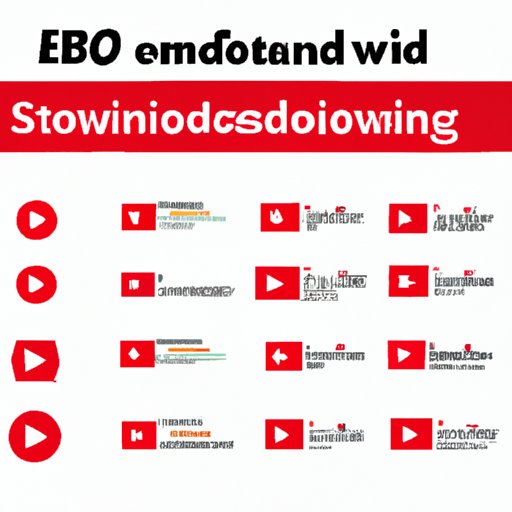Introduction
If you’re using Windows 10 and struggling to record your screen, you’re not alone. Many people find it difficult to navigate the settings and options required to start a successful screen recording on Windows 10. This article aims to help provide you with some guidance on how to record your screen on Windows 10 and introduce some software tool options to make the process easier.
Step-by-Step Guide to Screen Recording on Windows 10
The steps required to start and stop screen recording on Windows 10 are relatively straightforward, but it can be challenging for those who are new to the process. Here’s a step-by-step guide:
Accessing the Game Bar
Before you can record your screen, you need to access the Game Bar. You can do this by:
1. Pressing the Windows key + G to bring up the Game Bar
2. If the prompt “Do you want to open the Game bar?” appears, press “Yes, this is a game” to continue.
3. Once the Game Bar is open, you’ll have access to the screen recording options.
Starting, Pausing, and Stopping Recording
Once the Game Bar is open, you can start, pause, and stop recording:
1. Click on the “Record” button (shown as a red dot) to begin recording.
2. Alternatively, use the Windows key + Alt + R to start recording.
3. Click on the “Pause” button to pause the recording, then click it again to resume recording.
4. To stop recording, click on the “Stop” button (shown as a square) or use the Windows key + Alt + R to stop recording.
Screen Recording Software Tools for Windows 10
While the built-in screen recording functionality built into Windows 10 is useful, there are other software tools you might consider using for more advanced Screen recording tasks. Here are some of the most popular options:
OBS Studio
OBS Studio is a free, open-source screen recording software that’s popular in the streaming community. It’s easy to use and has a range of features, including custom web-page overlays, customizable hotkeys, and Greenscreen mode. OBS Studio is free to use and available on Windows, macOS, and Linux.
Bandicam
Bandicam is another popular screen-recording software, known for its high-quality video recording capabilities. It’s a paid application, but it does offer a free version with a 10-minute video limit. Bandicam is available for Windows.
Camtasia
Camtasia is a video editing and screen recording software with a range of features, including the ability to record from multiple sources, add animations and effects to recordings, and additional features for post-production video editing. It’s a paid application, but it does offer a 30-day free trial version. Camtasia is available for Windows and macOS.
EZVID
EZVID is an intuitive screen-recording software that includes advanced features like speech synthesis, on-screen drawing tools, and video effects. It’s a free application and available for Windows.
The Use of Built-In Windows 10 App for Screen Recording
Microsoft’s Xbox Game Bar app is a handy and versatile tool for screen recording, especially for gaming content. Here are its key features:
– In-Game overlay: This allows you to adjust your screen’s brightness and volume without leaving the game.
– Social features: You can communicate with other Game Bar users and share content on social media platforms.
– Built-in audio mixer: Control the volume of background audio and game sound independently.
Alternative Screen Recording Software Solutions
If you’re interested in exploring other screen recording tools outside of those listed above, here are some additional options to consider:
– Jing: A free screen recording software that also allows for image capture.
– Flashback Express: A free version of Flashback Pro, allowing for video recording, editing and advanced features will require a paid version.
– ShareX: This free open-source software allows screen recording and even GIF creation.
Tips and Tricks for Great Screen Recording
While having the optimal software tools is a great start, here are some tips for optimizing your screen recording workflow and create better videos:
Selection of Recording Settings
It’s crucial to choose the right recording settings before you start capturing video. This includes factors like the resolution, frame rate, audio quality, and bitrate. The optimal settings will depend on the content you want to record and the hardware you are using.
Choosing the Right Codec
Codec selection is important because it determines the level of compression the video undergoes without a loss in quality. Selecting the right codec will create smaller video files without losing the recording’s quality.
Framing and Composition Tips
The composition of your recording is important as it determines how well it will be received by your audience. Like the rule of thirds, the golden ratio, and the use of framing devices such as lines and grids can all help to improve your screen recording’s aesthetics.
Post-Recording Editing Ideas
Editing your video can be the difference between an average recording, and an exceptional one. Using software like Adobe Premiere or Davinci Resolve allows you to carry out additional editing options on videos such as cutting, adding audio, or inserting transitions.
Conclusion
Recording Screen on Windows 10 may seem like a daunting process, but it can be achieved using the built-in software or one of the other popular software tools outlined above. By considering the tips and tricks discussed, you can improve the overall quality of your screen recordings and provide your audience with exceptional content.
